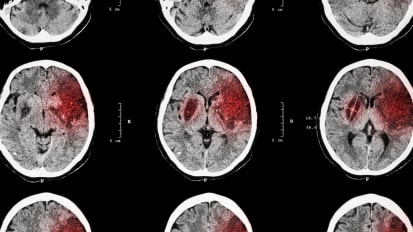University Hospitals System Stroke Update 2016 and 11th Annual Neuroscience Nursing Symposium
This is a NON-CME activity
Update on the New Guidelines for Endovascular Therapy for Acute Ischemic Stroke
Update on the New Guidelines for Endovascular Therapy for Acute Ischemic StrokeLessons from TEAM: What Patients Need to Hear from Us to Get Healthier
Lessons from TEAM: What Patients Need to Hear from Us to Get HealthierStroke Update 2016 - New Anticoagulants Therapies for Stroke Prevention with Atrial Fibrillation
Stroke Update 2016 - New Anticoagulants Therapies for Stroke Prevention with Atrial FibrillationTarget Audience
Physicians, Nurses, Other Allied Health professionals
Learning Objectives
- Discuss pre-hospital assessment, triage and decision making for patients with suspected acute stroke. Review the goals of Advance Stroke Life Support training.
- Review the indications and absolute vs relative contraindications for IV tPA therapy. Discuss controversial situations such as pregnancy, remote traumatic hemorrhage, stroke after a series of TIAs, elderly demented patients.
- Discuss the recent clinical trials of stent-retriever therapy for establishing reperfusion after acute ischemic stroke. Review the 2015 AHA/ ASA Guidelines for Endovascular Therapy for Acute Ischemic Stroke. Discuss the UH Systems Stroke Program guidelines for early evaluation and management of acute suspected stroke.
- Discuss and illustrate the treatment options for securing intracranial aneurysms. Review aspects of decision- making for individualizing patient treatment plans.
- Review the 2015 AHA/ ASA Guidelines for management of patients with non-traumatic ICH. Discuss the UH Systems Stroke Program guidelines for management of low-risk ICH.
- Review the AHA/ASA Guidelines on the management of asymptomatic carotid stenosis. Discuss the CREST-2 trial rationale and aims.
- Discuss the goals of rehabilitation therapy and anticipated outcomes after stroke. Review options for patient recovery in the early and late phases following stroke.
- Discuss the best approaches to educating our patients
- Review the new anticoagulants and their pharmacologic properties. Discuss the CHADS2VASC scoring and AHA/ ASA Guidelines for antithrombotic therapy with AF.
- Review the data supporting sleep apnea as a stroke risk factor. Discuss the diagnosis and management of sleep apnea complicating acute stroke.
Media
Recorded slides and audio presentation. Power point slides with videos.
Planning Committee
Cathy Sila MD, FAHA
Julie Fussner BSN, RN, CPHQ, SCRN
Danielle Sindelar MSN, RN, CMSRN
Erin Supan MSN. RN, CNS, CNRN
Ed Kuzma BSN, RN
Kelly Montgomery BSN, RN, SCRN
Ann Phillips BSN, RN
Barbara Bryson
No planning committee member reported a financial relationship with a commercial interest relevant to this activity.
Accreditation Statement

Case Western Reserve University School of Medicine is accredited by the Accreditation Council for Continuing Medical Education to provide continuing medical education for physicians.
Case Western Reserve University School of Medicine designates this enduring material for a maximum of 5.25 AMA PRA Category 1 CreditsTM. Physicians should claim only the credit commensurate with the extent of their participation in the activity.
Disclosure Statement
The policy of Case Western Reserve University School of Medicine CME Program (CWRU CME) requires that the Activity Director, planning committee members and all activity faculty (that is, anyone in a position to control the content of the educational activity) disclose to the activity participants all relevant financial relationships with commercial interests. Where disclosures have been made, conflicts of interest, real or apparent, must be resolved. Disclosure will be made to activity participants prior to the commencement of the activity. CWRU CME also requires that faculty make clinical recommendations based on the best available scientific evidence and that faculty identify any discussion of “off-label” or investigational use of pharmaceutical products or medical devices.
Instructions
To receive a statement of credit for up to 5.25 AMA PRA Category 1 CreditsTMyou must:
- Review and reflect on the full content of the recorded session.
- Successfully complete the post-test. A score of 75% is required for passage.
- Complete the evaluation.
Your credits will be recorded by the CWRU CME Program and made a part of your cumulative transcript. Credits are awarded on a per-module basis.
Estimated Time to Complete this Educational Activity
Including review of any resource material and completion of the post-test, this activity is expected to take 5.25 hours to complete if all modules are done.
Fee
There is no fee for this program.
To contact the CME Provider: Email CWRU CME at medcme@case.edu
Medical Disclaimer
Medicine is an ever-changing science. As new research and clinical experience broaden our knowledge, changes in treatment and drug therapy are required. The authors have checked with sources believed to be reliable in their efforts to provide information that is complete and generally in accord with the standards accepted at the time of publication.
Although every effort is made to ensure that this material is accurate and up-to-date, it is provided for the convenience of the user and should not be considered definitive. Since medicine is an ever-changing science, neither the authors nor Case Western Reserve School of Medicine nor any other party who has been involved in the preparation or publication of this work warrants that the information contained herein is in every respect accurate or complete, and they are not responsible for any errors or omissions or for the results obtained from the use of such information.
Readers are encouraged to confirm the information contained herein with other sources. This information should not be construed as personal medical advice and is not intended to replace medical advice offered by physicians. Case Western Reserve University School of Medicine will not be liable for any direct, indirect, consequential, special, exemplary, or other damages arising therefrom.
Resources
1) Guidelines for the Early Management of Patients With Acute Ischemic Stroke: A Guideline for Healthcare Professionals From the American Heart Association/American Stroke Association. Edward C. Jauch, Jeffrey L. Saver, Harold P. Adams, Jr, Askiel Bruno, J.J. (Buddy) Connors, Bart M. Demaerschalk, Pooja Khatri, Paul W. McMullan, Jr, Adnan I. Qureshi, Kenneth Rosenfield, Phillip A. Scott, Debbie R. Summers, David Z. Wang, Max Wintermark and Howard Yonas Stroke. 2013;44:870-947; originally published online January 31, 2013
2) 2015 AHA/ASA Focused Update of the 2013 Guidelines for the Early Management of Patients With Acute Ischemic Stroke Regarding Endovascular Treatment, Stroke; 46: June 2015
3) Guidelines for the Management of Spontaneous Intracerebral Hemorrhage A Guideline for Healthcare Professionals From the American Heart Association/American Stroke Association. J. Claude Hemphill III, MD, MAS, FAHA, Chair; Steven M. Greenberg, MD, PhD, Vice-Chair; Craig S. Anderson, MD, PhD; Kyra Becker, MD, FAHA; Bernard R. Bendok, MD, MS, FAHA; Mary Cushman, MD, MSc, FAHA; Gordon L. Fung, MD, MPH, PhD, FAHA; Joshua N. Goldstein, MD, PhD, FAHA; R. Loch Macdonald, MD, PhD, FRCS; Pamela H. Mitchell, RN, PhD, FAHA; Phillip A. Scott, MD, FAHA; Magdy H. Selim, MD, PhD; Daniel Woo, MD, MS; on behalf of the American Heart Association Stroke Council, Council on Cardiovascular and Stroke Nursing, and Council on Clinical Cardiology Stroke. 2015; 46:2032-2060 published online May 28, 2015
4) Guidelines for the management of Aneurysmal Subarrachnoid Hemorrhage: A Guideline for Healthcare Professionals from the American Heart Association/American Stroke Association. E. Sander Connolly, Jr., Alejandro A. Rabinstein, J. Ricardo Carhauapoma, Colin P. Derdeyn, Jacques Dion, Randall T. Higashida, Brian L. Hoh, Catherine J. Kirkness, Andrew M. Naidech, Christopher S. Ogilvy, Aman B. Patel, B. Gregory Thompson and Paul Vespa. Stroke. 2012; 43:1711-1737; published online May 3, 2012.




















